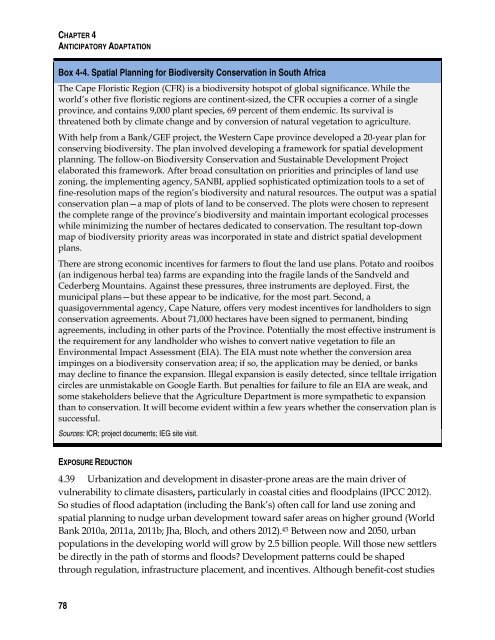Adapting to Climate Change: Assessing the World Bank Group ...
Adapting to Climate Change: Assessing the World Bank Group ...
Adapting to Climate Change: Assessing the World Bank Group ...
You also want an ePaper? Increase the reach of your titles
YUMPU automatically turns print PDFs into web optimized ePapers that Google loves.
CHAPTER 4ANTICIPATORY ADAPTATIONBox 4-4. Spatial Planning for Biodiversity Conservation in South AfricaThe Cape Floristic Region (CFR) is a biodiversity hotspot of global significance. While <strong>the</strong>world’s o<strong>the</strong>r five floristic regions are continent-sized, <strong>the</strong> CFR occupies a corner of a singleprovince, and contains 9,000 plant species, 69 percent of <strong>the</strong>m endemic. Its survival isthreatened both by climate change and by conversion of natural vegetation <strong>to</strong> agriculture.With help from a <strong>Bank</strong>/GEF project, <strong>the</strong> Western Cape province developed a 20-year plan forconserving biodiversity. The plan involved developing a framework for spatial developmentplanning. The follow-on Biodiversity Conservation and Sustainable Development Projectelaborated this framework. After broad consultation on priorities and principles of land usezoning, <strong>the</strong> implementing agency, SANBI, applied sophisticated optimization <strong>to</strong>ols <strong>to</strong> a set offine-resolution maps of <strong>the</strong> region’s biodiversity and natural resources. The output was a spatialconservation plan—a map of plots of land <strong>to</strong> be conserved. The plots were chosen <strong>to</strong> represent<strong>the</strong> complete range of <strong>the</strong> province’s biodiversity and maintain important ecological processeswhile minimizing <strong>the</strong> number of hectares dedicated <strong>to</strong> conservation. The resultant <strong>to</strong>p-downmap of biodiversity priority areas was incorporated in state and district spatial developmentplans.There are strong economic incentives for farmers <strong>to</strong> flout <strong>the</strong> land use plans. Pota<strong>to</strong> and rooibos(an indigenous herbal tea) farms are expanding in<strong>to</strong> <strong>the</strong> fragile lands of <strong>the</strong> Sandveld andCederberg Mountains. Against <strong>the</strong>se pressures, three instruments are deployed. First, <strong>the</strong>municipal plans—but <strong>the</strong>se appear <strong>to</strong> be indicative, for <strong>the</strong> most part. Second, aquasigovernmental agency, Cape Nature, offers very modest incentives for landholders <strong>to</strong> signconservation agreements. About 71,000 hectares have been signed <strong>to</strong> permanent, bindingagreements, including in o<strong>the</strong>r parts of <strong>the</strong> Province. Potentially <strong>the</strong> most effective instrument is<strong>the</strong> requirement for any landholder who wishes <strong>to</strong> convert native vegetation <strong>to</strong> file anEnvironmental Impact Assessment (EIA). The EIA must note whe<strong>the</strong>r <strong>the</strong> conversion areaimpinges on a biodiversity conservation area; if so, <strong>the</strong> application may be denied, or banksmay decline <strong>to</strong> finance <strong>the</strong> expansion. Illegal expansion is easily detected, since telltale irrigationcircles are unmistakable on Google Earth. But penalties for failure <strong>to</strong> file an EIA are weak, andsome stakeholders believe that <strong>the</strong> Agriculture Department is more sympa<strong>the</strong>tic <strong>to</strong> expansionthan <strong>to</strong> conservation. It will become evident within a few years whe<strong>the</strong>r <strong>the</strong> conservation plan issuccessful.Sources: ICR; project documents; IEG site visit.EXPOSURE REDUCTION4.39 Urbanization and development in disaster-prone areas are <strong>the</strong> main driver ofvulnerability <strong>to</strong> climate disasters, particularly in coastal cities and floodplains (IPCC 2012).So studies of flood adaptation (including <strong>the</strong> <strong>Bank</strong>’s) often call for land use zoning andspatial planning <strong>to</strong> nudge urban development <strong>to</strong>ward safer areas on higher ground (<strong>World</strong><strong>Bank</strong> 2010a, 2011a, 2011b; Jha, Bloch, and o<strong>the</strong>rs 2012). 45 Between now and 2050, urbanpopulations in <strong>the</strong> developing world will grow by 2.5 billion people. Will those new settlersbe directly in <strong>the</strong> path of s<strong>to</strong>rms and floods? Development patterns could be shapedthrough regulation, infrastructure placement, and incentives. Although benefit-cost studies78

















